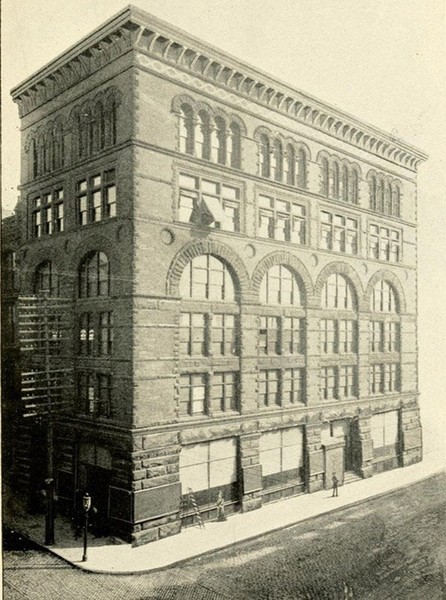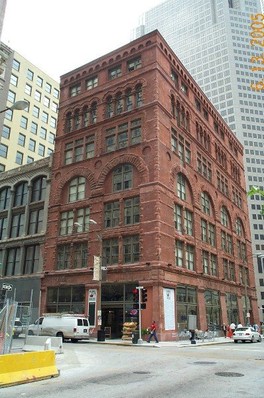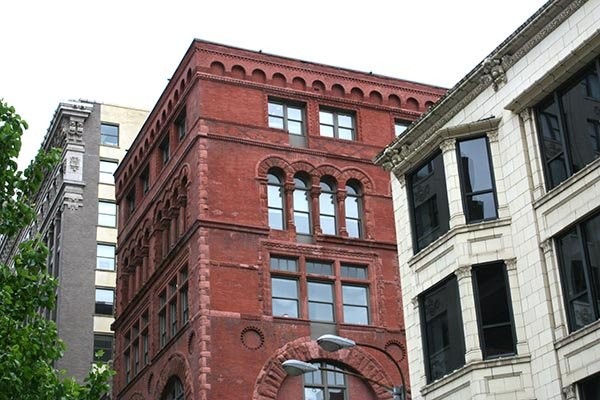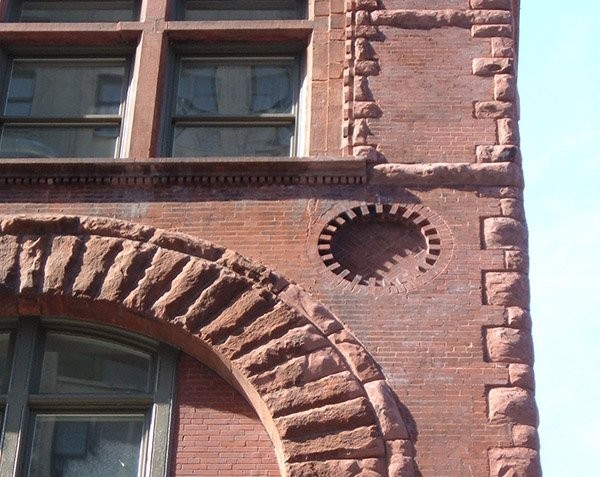Bell Telephone Building, St. Louis, aka The S.G. Adams Building
Introduction
Text-to-speech Audio
Images
Original appearance of the Bell Telephone Building

Exterior of the Bell Telephone Building

Another view of the building's exterior

Detail of exterior

Backstory and Context
Text-to-speech Audio
Between 1917 and 1920, the St. Louis Bell Telephone Company expanded greatly when it merged with three other phone companies serving Missouri, Texas, Kansas, Arkansas and Oklahoma: this system became known as Southwestern Bell Telephone Company. Two more towers were constructed in the city by Southwestern Bell, one completed in 1926 just southwest of the original building, and another tower to the east in the 1980s.
One of America's most significant, though brief, architectural trends in the late 1880s was based on the highly personal style of prominent Boston architect H. H. Richardson. Characteristics of the style include the use of heavy rugged masonry; Romanesque arches or arcades; battered bases offering the appearance of greater mass; compact silhouettes; and carved stone detail, particularly Romanesque or Byzantine motifs. George F. Shepley of Shepley, Rutan & Coolidge, who was a St. Louis native, was Richardson's son-in-law. (In the 1890s, his firm would turn to the increasingly popular Renaissance Revival style.)
Two bays wide at the north (Olive Street) side and four bays wide at the west (Tenth Street) side, the building includes three-story arcades springing from ground-level storefronts. The fifth and sixth floors use progressively smaller windows, grouped at each bay. The addition of the seventh floor in 1919 was constructed in a compatible style and does not obscure the original Richardsonian design. The other major alteration was the addition of limestone sheathing to the first floor in 1940, typical of storefronts in downtown St. Louis. Despite the subsequent modifications, the building retains the architects' essential clarity.
When Southwestern Bell moved out of the building, ownership was taken over by the S.G. Adams Printing Company, which began in the 19th Century as an office supply company and later became the first manufacturer of license plates. (They were also the first license-plate company to make use of the Federal prison system to employ its inmates to manufacture its products.) In 1959, Comfort Printing and Stationery purchased S.G. Adams, but retained the name. This company went bankrupt in 2001. The vacant ground floor was then occupied by City Grocers in 2004, which closed in 2010. The upper floors have been renovated as the Bell Lofts apartments.
Sources
Josse, Lynn. “NHRP Registration Form: Bell Telephone Building.” United States Department of the Interior: National Park Service. Publication Date: 6/29/99. Access Date: 3/31/19. https://dnr.mo.gov/shpo/nps-nr/99000936.pdf
“S.G. Adams Building.” Built St. Louis. Access Date: 3/31/19. http://www.builtstlouis.net/opos/sgadams.html
Vise, Marilyn. “S.G. Adams quits paper chase, files for bankruptcy.” St. Louis Business Journal. Publication Date: 7/15/01. Access Date: 3/31/19. https://www.bizjournals.com/stlouis/stories/2001/07/16/story5.html
BruceS. “Bell Telephone Building aka S.G. Adams Building - St. Louis, Missouri.” Waymarking.com. Publication Date: 8/5/06. Access Date: 3/31/19. http://www.waymarking.com/waymarks/WMK6X_Bell_Telephone_Building_aka_SGAdams_Building_St_Louis_Missouri
“Name: Bell Telephone Company Building.” Mound City on the Mississippi. Access Date: 3/31/19. https://dynamic.stlouis-mo.gov/history/structdetail.cfm?Master_ID=1720
“Hartley B. Comfort Building - City Landmark #114.” StLouis-Mo.gov. Access Date: 3/31/19. https://www.stlouis-mo.gov/government/departments/planning/cultural-resources/city-landmarks/Hartley-B-Comfort-Building.cfm
